Level crossings in the United Kingdom
There are around 6,000 level crossings in the United Kingdom, of which about 1,500 are public highway crossings.[1] This number is gradually being reduced as the risk of accidents at level crossings is considered high. The director of the UK Railway Inspectorate commented in 2004 that "the use of level crossings contributes the greatest potential for catastrophic risk on the railways."[2] The creation of new level crossings on the national network is banned (the exception being reopening unavoidable crossings on new/reopening railway lines, and on heritage railways), with bridges and tunnels being the more favoured options. The cost of making significant reductions, other than by simply closing the crossings, is substantial; some commentators argue that the money could be better spent. Some 5,000 crossings are user-worked crossings or footpaths with very low usage. The removal of crossings can improve train performance and lower accident rates, as some crossings have low rail speed limits enforced on them to protect road users (e.g. AOCLs). In fact, between 1845 and 1933,[3] there was a 4 miles per hour (6.4 km/h) speed limit on level crossings of turnpike roads adjacent to stations for lines whose authorising Act of Parliament had been consolidated in the Railways Clauses Consolidation Act 1845 although this limit was at least sometimes (and possibly often) disregarded.[4][5][6]
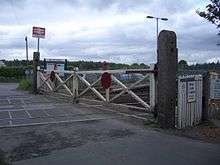


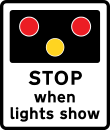
History
Gated level crossings were mandatory from 1839, but initial rules were for the gates to be ordinarily kept closed across the highway.[7] The original form of road level crossing on British railways dates from 1842 onwards,[7] it consisted of two or four wooden gates (one or two on each side of the railway). When open to road traffic, the gates were closed across the railway to prevent horses and livestock inadvertently escaping onto the railway. The gates were operated by railway staff usually by hand or later by capstan wheel from a signal box and they were generally interlocked with the signal/s protecting the crossing. Where a signal box was not nearby but road traffic still warranted a full gated crossing a dedicated crossing keeper would be employed, often living in a railway-owned cottage adjacent to the crossing and in communication with the signal boxes via the telegraph system.
In 1955 various European countries were visited and automatic crossings examined by two inspecting officers from the Railways Inspectorate (HMRI), two road engineers from the Ministry of Transport, and two officers from the British Transport Commission (see Hixon rail crash). They visited 46 crossings in 10 days in three countries; Belgium, France and the Netherlands. The report was signed on 14 March 1957, and automatic and automated crossings came into use, with the first automatically operated level crossing commencing operation at Spath near Uttoxeter in Staffordshire in May 1961.[8] Automatic half-barrier crossings later came into being after another enquiry abroad in 1963, consisting of a single arm each side of the road, which block only oncoming traffic leaving the exits clear. Half barriers were originally considered to have an advantage as they had a short closure time and did not require to be interlocked with signals.
After the Hixon rail crash in 1968, it became clear that more warnings were needed for large vehicles at AHBCs (Automatic Half Barrier Crossings). The vehicle in question (a low-load transporter carrying a large electrical transformer), despite being escorted by police, was struck by a train whilst crossing the tracks at 2 miles per hour (3.2 km/h) on an AHBC installed a year before. The changes made to AHBCs were additional information signage, telephones to signal boxes and the addition of a preliminary amber light to the pair of red lights at all crossings (plus a now defunct 'Another train coming' illuminated box; now just a piece of signage is needed). Provision of telephones at these crossings had been opposed by Colonel Reed of the Railways Inspectorate (HMRI), although some BR managers still installed them. Colonel McMullen of HMRI had stated in 1957 that if AHBs (Automatic Half Barriers) were adopted "the principle must be recognised that it is the responsibility of the individual to protect himself from the hazards of the railway in the same was as from the hazards of the road". Wynns, the operator of the low-load transporter had received a terse reply from British Rail when they wrote about a near-disaster with a slow transporter in Leominster in 1966.[9]
The Automatic Open Crossing (now known as AOCL, with the L standing for Locally monitored) was introduced in 1963. These have no barriers, a St Andrew's Cross above each warning light, and have an indicator light to show correct working. The first to be installed was at Yafforth in North Yorkshire in 1963. These crossings were cheaper than installing AHBCs and were much suited to quiet country lanes, which is why many more were installed in the 1970s, albeit destined to be replaced by AOCRs (Automatic Open Crossing Remotely monitored) as they had a greater line speed potential and were even cheaper than AOCLs. The first of these AOCRs to be installed was at Naas crossing near Lydney, Gloucestershire in 1983. These continued to be installed until the Lockington rail crash occurred in 1986, which saw the demise of this type of crossing with nearly all AOCRs being upgraded to AHBCs. Only one remains in the UK at present; on the national network at Rosarie, near Keith, Moray.
The Ufton Nervet rail crash in 2004 was an eye-opener for many people involved with level crossings and since then the highlight on crossing safety has increased, with crossings being closed or upgraded; most notably AOCLs being upgraded to Automatic Barrier Crossing Locally monitored (ABCL) status. In 2009 after the Halkirk crossing crash in Scotland, it was seen that the AOCLs on the network were the most dangerous crossing and a scheme to eradicate them was put forward. In order to do it quickly and cheaply, the full conversion to ABCL status was not done, and instead the simple addition of barriers to create an AOCL+B was the go to option. Upgrades and closures still continue into the future, with newer systems (and trials of different equipment) such as the AFBCL (Automatic Full Barrier Crossing Locally monitored) being installed in Ardrossan in 2018.
Safety
After the Ufton Nervet rail crash, there have been increased efforts to review the placing of level crossings and to eliminate them where this is practicable. In the UK it has also been suggested that cameras similar to the type used to detect drivers who run traffic lights be deployed at level crossings, and that penalties for ignoring signals should be much more severe.
British Transport Police typically prosecute motorists who jump the barriers, for either trespass or failing to conform with a traffic signal. A particular problem has been that the responsibility for road safety at crossings is entirely outside the control of the railways. In 2006 there were legal proposals to permit Network Rail to be involved in the road side safety of crossings. This would allow the introduction of anti-slip surfaces and also barriers to prevent motorists driving around crossing arms and, it is hoped, reduce the number of crossing-related deaths.
Network Rail is pursuing a policy of closing level crossings at the rate of over 100 a year in the interests of safety, and replacing them with road bridges or footbridges.[10] The number of level crossings on rail lines controlled by Network Rail went from 7,937 in 2003-04[11] to 6,322 in 2013-14,[12] and 5,887 by 2016-17.[13] The number of crossings rose to 5,939 in 2017-18. This was due to the increased number of footpath crossing with and without lights compared to the number reported in 2016-17. This is due to a change in the categorisation of level crossings when they are added to the All Level Crossing Risk Model (ALCRM) and doesn't represent a physical increase in the number of crossings on the network.[13]
For the episode of British motoring television programme Top Gear on 25 February 2007, Network Rail staged an incident in which a locomotive was driven into a Renault Espace at around 80 miles per hour (130 km/h) at an AHB level crossing at Hibaldstow, Lincolnshire to graphically illustrate the dangers of "running the risk" (see British Rail Class 31 in the media).
Types of crossing
MG – manually controlled gates
These legacy gated crossings are locally operated by a signaller or other railway staff. They consist of wooden or metal gates that close against road traffic and may be operated by hand; operated by a wheel; driven by a motor; or more recently at Redcar, gates that are electrically telescopic. When closed to road traffic, the gates are detected/locked and the protecting signal/s can be released. These crossings no longer meet current safety standards and are being renewed with more modern designs of barrier crossings.
MCB – manually controlled barriers
An MCB crossing is controlled by an adjacent signalbox where the signalman can view the road closure and determine that the crossing is clear before releasing the protecting signals. Normally an MCB crossing either has two full road width barriers or four half road width barriers that fully close the road. This type of crossing also has standard road-lights and alarms that operate when closing. The first crossing of this type was tested at Warthill, North Yorkshire in 1952.
MCBR – manually controlled barriers remotely monitored
An MCBR is exactly the same as an MCB crossing except that the controlling signalbox is not directly next to the crossing, but can be within 1⁄4 mile (400 m) of the crossing. The signaller requires a clear view of the crossing to determine that the crossing is clear before releasing the protecting signals. In poor viewing conditions such as mist, fog or falling snow it may be necessary to appoint an additional person placed at the crossing to advise the signaller that the crossing is clear. An example of this type of crossing is at Driffield, East Riding of Yorkshire.
MCB-CCTV – manually controlled barriers monitored with closed circuit television
A MCB-CCTV is the same as an MCB crossing except that it may be many miles away from the controlling signal box. CCTV cameras mounted in close proximity to the crossing enables the signaller to monitor the road closure and to determine the crossing is clear, before releasing the protecting signals. This type of crossing has caused many crossing signal boxes to become redundant on various lines across the country. The first crossing of this type was trialled at Funtham's Lane, near Peterborough, Cambridgeshire in 1970.
MCB-OD – manually controlled barriers monitored by obstacle detection
These crossings are MCBs except that instead of a signaller, the obstacle detection equipment monitors the closure of the crossing and determines that the crossing is clear before releasing the protecting signal. The crossing is initiated by approaching trains and has no direct signaller involvement when working normally, apart from monitoring the process. The obstacle detection uses LIDAR and RADAR systems to detect that the crossing is clear, if it is not the sequence is disrupted and any approaching train would come to a stand at the protecting signal. The signaller would then be required to initiate an alternative operating procedure. This type of crossing has become much more common on many lines through the country and these crossings are now considered the safest of the modern types. The first crossing of this type was developed and tested in 2010, at a level crossing at Filey, North Yorkshire.
MCB-OC – manually controlled barrier crossing on call
These crossings are exactly the same as MCB-CCTV crossings except the barriers stay down and the lights stay off. When a user wants to cross, they have to press a button to notify the signaller, who will raise the barriers if there is no train. There are only a handful of these in the UK, one being at Barnetby, Lincolnshire.
AHBC – automatic half barrier crossing
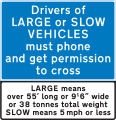
Automatic Half Barrier crossings are initiated by approaching trains and are not interlocked with signals, although they are monitored by a signaller for correct operation. The maximum rail line speed over these crossings is 100 miles per hour (160 km/h) and only a maximum of two tracks can be crossed. The crossings have two half-barriers that only close the entrance lanes to the crossing, standard crossing road-lights and audible alarms. At the maximum rail line speed, the crossing warning time is typically about 27sec from the Amber light first showing to the train arriving at the crossing. These crossing were originally designed for use on roads with infrequent traffic. No new crossings of this type are likely to be installed and many AHBs are being renewed as MCB-OD or MCB-CCTV. In recent years, some audible alarms at AHBs have been updated to include spoken warnings as a means to improve safety. The first crossing of this type in the UK was installed in the town of Spath, near Uttoxeter in Staffordshire, and began operating on 5 February 1961.
AOCL – automatic open crossing locally monitored
An open crossing, with conventional road-lights and audible alarms, but no barriers. On twin tracks an 'Another Train Coming' light is provided which flashes a red light with an 'another train coming' message when appropriate. Designed for low traffic railway lines and low traffic roads, the maximum line speed over these crossings is 55 miles per hour (89 km/h). On the railway approach, a Drivers Crossing Indicator(DCI) shows a flashing red light when the crossing is open to road traffic. The crossing should initiate when a train passes a sign with a black St Andrew's Cross on a white background, on the approach to the crossing. If the crossing is operating correctly, the flashing red light changes to a flashing white light. The driver of the train is responsible for monitoring that the flashing white light is showing and that the crossing is clear before proceeding at up-to line speed over the crossing, if not the train should be brought to a stand before the crossing and the relevant rules followed before proceeding. This type of crossing was initially popular as many crossings were destaffed reducing costs. However, after the 1986 Lockington level crossing accident and the Stott independent review of automatic open level crossings, many AOCLs were renewed as ABCLs. Since that time, a disproportionate number of accidents have occurred on the remaining AOCLs, leading to many having barriers being added and changing the designation to AOCL+Bs. The first AOCL was installed at Yafforth, North Yorkshire in 1963.
AOCR – automatic open crossing remotely monitored
These crossings were popularly installed when one was first trialled in 1983 (at Naas level crossing, near Lydney, Gloucestershire), because they lowered costs due to the lack of barriers, and they could be used on many country lanes. Acting in the same way as an AHBC, they do not interlock with signals, but they had a 75 miles per hour (121 km/h) line speed. After the Lockington rail crash in 1986, their demise began due to their safety issues, and now only one still exists in the country at Rosarie in Scotland near Keith, Moray.
ABCL – automatic barrier crossing locally monitored
This type of crossings is a direct development of the AOCL which resulted after the Stott independent review of automatic open level crossing following the 1986 Lockington level crossing accident. They have a maximum line speed over the crossing of 55 miles per hour (89 km/h). Many AOCRs and AOCLs were subsequently renewed as ABCLs. The crossing initiation and operation of the Drivers Crossing Indicators is the same as the AOCL/AOCL+B. The first to be installed was on the A146 Beccles bypass, Suffolk, in 1988.
AOCL+B – automatic open crossing locally monitored + barriers
These have existed since 2012, the first being at Ardrossan Harbour, North Ayrshire, and are the cheap version of the ABCL, brought about by RAIB suggesting Network Rail fit barriers to AOCLs after a crash at an AOCL in Halkirk, Highland.[14] In an AOCL+B upgrade, the barriers are added into the AOCL's circuitry instead of replacing the whole system as at an ABCL upgrade. They can be recognised by the alarm switching off before the barriers rise once a train has passed, and by not having telephones as ABCLs do.
AFBCL – automatic full barrier crossing locally monitored
This is a recent type of crossing, the first being at Ardrossan Princes Street crossing in early 2018 and two more installed at Dingwall Middle and No.1 crossings in November 2018. These crossings are the enhanced version of the ABCL, with full barriers. This is intended for locally monitored crossings with a high level of misuse by pedestrians, or a risk of misuse. Obstacle detection equipment (LIDAR only) is provided, since automatic full barrier crossings without them can trap a vehicle if not proven it's clear before lowering. The exit (offside) barriers will not descend unless the crossing is proved clear of vehicles and pedestrians by obstacle detection equipment. Unlike the standard full barrier type crossings, the alarms remain on when the barriers have completed their descend, just like any automatic half-barrier crossing, and will stay on until the red lights stop flashing.
TMO – trainman-operated crossing
On small branch lines (e.g. Cambrian Line), these crossings are common as they require no monitoring by any signallers, and simply have to be observed by the train driver as being closed. The guard will push a button close to the crossing that activates it, and once lowered the train can cross safely. These appear to be MCB type crossings to the driver, but have a much shorter closing time (with the drawback of the train having to stop completely to activate the crossing).
MWL/MSL – miniature warning light/miniature stop light crossing
These crossings are designed for use at foot crossings or private roads (where the user has to operate the barriers/gates themselves at the latter). A small set of red and green lights alert the user as to the state of the railway; green for safe to cross, red for STOP, train approaching. These started to appear around 1964, and are still common today.
OC – open crossing
The open crossing only really exists on underused country lanes crossing lines with low and/or slow rail traffic. With a speed limit of 5 mph (8 km/h) and no lights or barriers/gates, these are rare, and are only marked by the signage and the St Andrew's Cross. Many can be found in southern Kent on the Dungeness branch of the Marshlink Line, and some in Cornwall on scenic railways. Others also scatter the country.
UWC – user worked crossing
The most common type of crossing on the railway network (around 2/3 of the total) and also the most basic type. These can either be a basic footpath crossing; a crossing with gates and instructional signage; or a crossing with a telephone to the nearest signalbox. In order to cross safely, users must read the instructions and comply with them. Whether they have to raise the barriers, open the gates, phone the signalman or simply cross under their own judgement varies depending on the danger the crossing poses. Normally phones are provided at crossings on high speed lines.
Barrow crossing
A barrow crossing is one found purely in railway stations which allows passengers, or other through users if it is a public right of way (PROW), the opportunity to cross between platforms. The name derives from the fact that it was used by station staff to carry the luggage of passengers across the tracks on barrows. Some barrow crossings are still in use at stations that do not have footbridges such as at Horton-in-Ribblesdale or at Thirsk, which does have a footbridge, but that footbridge is not accessible to wheelchair users. Some barrow crossings have a light display system of protection telling users when they can and cannot cross, or sometimes the station staff will accompany users.[15][16][17][18]
Equipment
Modern level crossings in Britain use a variety of different equipment to stop any traffic when an oncoming train crosses:
Warning lights
The modern warning lights used on level crossings in the UK consist of one amber light at the bottom and two red lights at the top, all on a black board with a checkerboard outline in red and white (the red and white borders weren't introduced until 1992; the borders were just white beforehand). The amber light has been in existence since the Hixon rail crash; previously there were just two red lights. The whole warning light module is known colloquially as a "wigwag" (due to the nature of the alternate flashes). They are also used at lifting and swing bridges, some airports, fire stations, police stations and ambulance stations in the UK. When a level crossing activates, the yellow light is usually illuminated for 3–5 seconds and then the two red lights flash alternately for the duration of the closure. The lights are normally rectangular and landscape orientated, but where space is limited or to improve visibility special lights can be fitted that are portrait orientated. In some cases a now non-standard traffic light type was fitted (still seen at Marshbrook, Minffordd and on the Isle of Man), consisting of the individual lights arranged vertically in a red–amber–red arrangement. Many of the lights nowadays are LEDs due to the cost efficiency, easy maintenance, and clarity, the first LED wigwags were trialled at Bentley Heath level crossing in 2006 but not fully adapted until July 2007. Incandescent halogen lights are no longer manufactured as they are wasteful on electricity and can cause accidents such as at Beech Hill Crossing in Nottinghamshire, in which a fatality occurred due to the lights' dimness in the low sunlight.[19] However old halogen lights and even LED lights are sometimes donated to heritage railways and used at their crossings, or simply scrapped in the case of some halogen lights. As well as road traffic, smaller pedestrian lights are used in populous areas or at dangerous crossings, where extra warning is needed. These consisting of a flashing red silhouette of a pedestrian, similar to what you would see at a pedestrian crossing. Some AOCL(+B) crossings with two tracks very occasionally have an 'Another Train Coming' warning light, a small red light with the overlay 'ANOTHER TRAIN COMING' that flashes when two trains are approaching. Historically, at twin track AHBCs, there was an 'ANOTHER TRAIN COMING` Neon sign that would flash when another train was approacing. Since the early 1980s, most of these have been removed and replaced with simpler signage, but they weren't fully extinct until around 2007/2008 (Beech Hill LC being one of the last with the illuminated 'another train coming' sign).
Audible alarms
Originally electrical bells were used at many crossings to produce a loud ringing alarm when the crossing was activated, and stopped when the barriers descended. This could either be a single-stroke bell that would ding once or twice a second, or a multi-stroke constantly ringing bell. These bells became normal practice until audible tone alarms started to be installed, replacing the ageing bells. Bells on some crossings can still be seen today although some are not as audible as today's standards. They can come attached to the post that the warning lights are on, or can come fitted to some older barrier pedestals.
Audible alarms (also known as 'Yodalarms') were first implemented on crossings in the late 1970s/early 1980s and continue to be used today as they are the safest way of warning traffic and pedestrians audibly of an approaching train. The Yodalarms (depending on what model) usually have different tones, alternate rates and different volumes (controlled by potentiometers) at different crossings, depending on how busy the crossing is, and whether residents are living nearby. Modern alarms have night modes (controlled by the crossing relays) that lower the volume in the night, the pitch usually goes lower and the alternate rate normally goes faster (depending on which yodalarm model it is), on some crossings (mainly of the older types) the alarms are switched off completely by the crossing controller at night. The alarm sounds from the moment the amber light is illuminated up to the point the barriers shut on a full barrier crossing, and the crossing is deactivated on all automatic crossings. The Yodalarm YO3 Electronic Alarm (Clifford & Snell / R.Stahl) type alarms were the original ones used and still are the most common. They produce a two tone (high pitch bleep, followed by a lower pitched bleep) alarm, that does tend to change over time due to general wear. They are found at almost every MCB crossing in Britain, and many more besides. At crossings with half barriers and two tracks, if another train is approaching after a first has crossed, the alarm will increase in speed to inform the users at the crossing that another train is due. Another type of alarm is the A105NAX Electronic Alarm (E2S), which started to be implemented on some crossings in 2010, and produce a more lower pitch assertive two tone sound. These alarms function the same as a Yodalarm at a half barrier crossing except their main property is that intermittently a verbal warning will play. This can either be "Warning, more than one train may be approaching" repeated twice during closure, or "Warning, another train is approaching" repeated twice if another train is due. Some crossings with equipment manufactured by Bombardier and Schweizer Electronic use a PA system instead of separate alarm units and play an audio file of the Yodalarm alternating signal. Some also play voice messages similar to the E2S signal in which "Warning, another train may be approaching" is repeated.
Gates and barriers
Wooden gates were the most common form of protecting level crossings in the UK, and were operated either by a signalman or a crossing keeper. All gated crossings across public highways had each gate fitted with a large red circle or more rarely, a diamond, to highlight that the gate was closed. Gates open to road traffic, mostly closed across the railway to stop herded livestock from straying onto the track. If a train was due, the gates would be swung manually or by a wheel mechanism from the adjacent signal box. When closed to road traffic, the gates would be interlocked with the signalling systems, locking the gates from opening and releasing the signals. These legacy crossings do not meet current standards and many have been renewed with modern systems. However, there are still a few on Network Rail and also on heritage lines. A system of motor driven boom-gates replaced some older gates, they had a motorised wheel that drove the gate across the road. These have nearly all been replaced due to reliability issues, most notable at Redcar.[20]
Barriers are the normal level crossing protector to be seen in the UK and now come in various models. All barriers at crossings are illuminated with barrier lights on the barrier arm, and are highlighted in red and white reflective stickers. Half barriers at level crossing are a simple boom arm that descends on the left hand foot way and left hand lane(s) of a road when the crossing activates and the warning lights have been on for about 10 seconds. Full barrier crossings have either two barriers covering the whole width of the road on either side, or four barriers covering half of the road on either side, that descend on the left hand lanes first and then the right hand lanes. These are supplied with a white skirting (red and white in older crossings) that fold up in the upright position, and stops small children, animals, and potential trespassers from crossing when the barriers are down. Where pedestrian traffic is sparse or there is a barrier separating the foot way from the road, only partial or no skirting ('skirts') may be used. In rare cases, both full and half barrier crossings can have three barriers that all descend at once.
Some early motor/gearbox driven and electro/hydraulic pedestals/barriers were made by Godwin Warren Engineering (GWE). The GWE Mk1 pedestal/barriers were installed at Manned Controlled Barrier (MCB) crossings between the late 1960s to the early 1980s. The Mk1 pedestals/barrier booms are recognised by the complex clamping arrangement on the pedestal sidearm which hold the aluminium booms and by the pogo-stick fitted to the end of the barrier used to support it in the down position. BR Western Region barriers were also installed at around the same time as the GWE barriers, these were hydraulically powered. Some were much longer than current electro/hydraulic barriers, but the hydraulics were hard to maintain and had noisy hydraulic pump motors. Both these legacy crossing systems has been targeted for renewal in recent years and few examples are now left. The standard pedestals/barriers used since the early 1980s are the Mk2(BR843 specification) type. These were originally made by GWE and later by 'Smiths Industries Hydraulics Company', who were re-branded 'SPX Fluid Power' in 2001, and re-branded again to their current name 'SPX Rail Systems' (as of 2005). The barrier booms are of aluminium and have a simple two bolt fixing which is designed to easily separate without damage should the barrier be hit. The booms descend by gravity and raise using an electro/hydraulic power pack mounted in the pedestal.
Barrier technology has been evolving in the 2010s, with many more systems being trialled and installed at crossings in the country. Invensys Rail S60 / Siemens barriers are a relatively new barrier design which was given a 'Certificate of Acceptance' by Network Rail in June 2012. They have been used at a vast range of MCB-OD crossings, originally trialled in Cheshire and Shropshire. The barrier design comes from the many railroad crossings in the United States. Invensys and Siemens had to make additional fittings (such as a housing fork, stand, caging and skirting) along with sufficient safety measures to allow the barrier design to be accepted in the UK. After trials at numerous crossings, no more of these barriers have been fitted since they have become unreliable (requiring maintenance) and occasionally unsafe (in strong winds). This may however now be a claim just for the English government, as one new crossing in North Wales (Tyn Y Morfa) has recently been fitted with this type of barrier (in March 2018).[21]
As well as these, as mentioned in the first paragraph, the troublesome gates at Redcar were replaced in 2015 with a new, exclusive telescopic sliding gate that slides across the road when a train is due. These were fitted with modern red and white reflective stripes as well as the red circle warning a seen on gates almost 100 years ago. The gates were implemented as a trial, and their future does not seem good as they have failed a couple of times in recent years.[22]
Finally, the most recent tests of not only barriers but barrier system was undertaken at Selby Road level crossing near Doncaster in April 2018.[23] These were Bombardier's EBI Gate 2000 barriers (also called the EBI Gate 630) which were used alongside the Bombardier EBI Gate 2000 system.[24] These have barrier arms that are safer in the event of them being hit, as they break in set places. They also have supporter pogo-sticks at the end of the barrier as did the GWE barriers beforehand. Several more of these crossings are due to be fitted and trialled in the north east.
Gallery
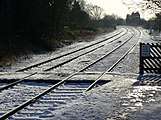 Barrow Crossing across the railway at Ruskington
Barrow Crossing across the railway at Ruskington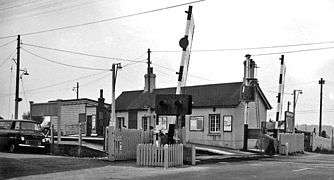 The original design of automated crossing at Berwick, East Sussex in 1964
The original design of automated crossing at Berwick, East Sussex in 1964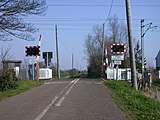 A half-barrier level crossing known as an AHBC near Waterbeach, Cambridgeshire
A half-barrier level crossing known as an AHBC near Waterbeach, Cambridgeshire Risk of grounding warning sign
Risk of grounding warning sign.jpg)
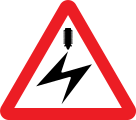 Electrified overhead cables warning sign
Electrified overhead cables warning sign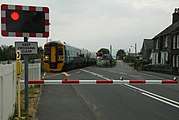
 The St Andrew's Cross that is displayed at all open crossings
The St Andrew's Cross that is displayed at all open crossings.jpg) The AOCL+B crossing at Winchelsea, East Sussex, with no telephone or AHBC signage
The AOCL+B crossing at Winchelsea, East Sussex, with no telephone or AHBC signage.jpg)
.jpg) A level crossing with obstacle detection at Pevensey & Westham, East Sussex, with the notable equipment in the background
A level crossing with obstacle detection at Pevensey & Westham, East Sussex, with the notable equipment in the background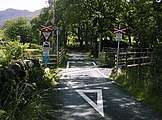 An open crossing on a narrow gauge heritage railway in Beddgelert, Gwynedd, with bilingual warning signage
An open crossing on a narrow gauge heritage railway in Beddgelert, Gwynedd, with bilingual warning signage The red and green stop light at a MWL foot crossing near Offord Cluny, Cambridgeshire. This is a major crossing across the high speed East Coast Main Line
The red and green stop light at a MWL foot crossing near Offord Cluny, Cambridgeshire. This is a major crossing across the high speed East Coast Main Line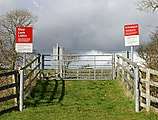 A simple farm crossing across a low traffic line near Llanwrtyd Wells, Powys. These crossings are the most common and require complete user compliance.
A simple farm crossing across a low traffic line near Llanwrtyd Wells, Powys. These crossings are the most common and require complete user compliance.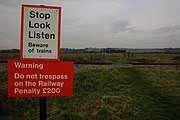 A basic footpath crossing near Fladbury, Worcestershire, with very simple signage
A basic footpath crossing near Fladbury, Worcestershire, with very simple signage
See also
References
- "Level crossing safety". Network Rail. Retrieved 23 July 2018.
- "Rail level crossings discouraged". BBC. 7 November 2004.
- Railways Clauses Consolidation Act 1845, s.48
- Attorney General v London & North Western Railway Co [1900] 1 QB 78
- The requirement that trains travel at 4mph across some level crossings was abolished by the Road and Rail Traffic Act 1933, Sch 3.
- Goodman, Michael (1977). "Railways in the Law Reports" (PDF). Trent Law Journal. 1 (1): 47. Archived from the original (PDF) on 23 July 2011. Retrieved 11 April 2017.
- "History of level crossings". Network Rail. Retrieved 8 February 2019.
- "New Summary: Automatic "Gates" Britain's first automatically operated level crossing barriers are now in operation at Spath Level Crossing near Uttoxeter. The barriers, electrically operated by an approaching train, consist of a single pole fixed each side of the road only, and are conspicuously marked with red and white bands. Additional warning is given by flashing red lights and audible alarms". Practical Motorist. 7 (81): 957. May 1961.
- "Ignorance from Arrogance in 24 seconds" by Fraser Pithie in The Railway Magazine (England): January 2018 (No 1402, Vol 164) pages 24-30
- "Level crossings". Network Rail. 2014. Retrieved 27 June 2015.
- http://researchbriefings.files.parliament.uk/documents/SN03255/SN03255.pdf
- http://www.rssb.co.uk/Library/risk-analysis-and-safety-reporting/2014-07-aspr-2013-14-full-report.pdf
- https://www.rssb.co.uk/Library/risk-analysis-and-safety-reporting/2017-07-report-annual-safety-performance-report.pdf
- "Fatal accident at Halkirk level crossing". GOV.UK. Retrieved 8 February 2019.
- Ellis, J W (2001). British Railway Track Volume 9; Track Terminology (7 ed.). Woking: Permanent Way Institution. p. 32. ISBN 0-903489-05-3.CS1 maint: ignored ISBN errors (link)
- "THIRSK STATION BARROW CROSSING REOPENS". networkrailmediacentre.co.uk. Retrieved 20 December 2018.
- "Barrow Crossing | Safety Central". safety.networkrail.co.uk. Retrieved 20 December 2018.
- "SCRCA Location Variant: Level Crossing – Barrow | SCRCA". scrca.foscl.org.uk. Retrieved 20 December 2018.
- "Report 17/2013: Collision at Beech Hill level crossing". GOV.UK. Retrieved 8 February 2019.
- Robson, Dave (5 February 2015). "Redcar level crossing may be replaced within a year due to inability to cope with strong winds". gazettelive. Retrieved 8 February 2019.
- "Tyn Y Morfa level crossing has also been upgraded to a manually controlled barrier with CCTV". Network Rail Media Centre. Retrieved 8 February 2019.
- Brown, Mike (12 March 2018). "Rush hour misery in Redcar as level crossing barriers get stuck". gazettelive. Retrieved 8 February 2019.
- BombardierRailUK (15 April 2018). "First Bombardier EBIGate2000 level crossing on the GB rail network with obstacle detection system now commissioned at Selby Road, Askern near Doncasterpic.twitter.com/dXmM4242GF". Retrieved 8 February 2019.
- "In case you missed it: Level crossings come of age". 30 December 2015. Retrieved 8 February 2019.